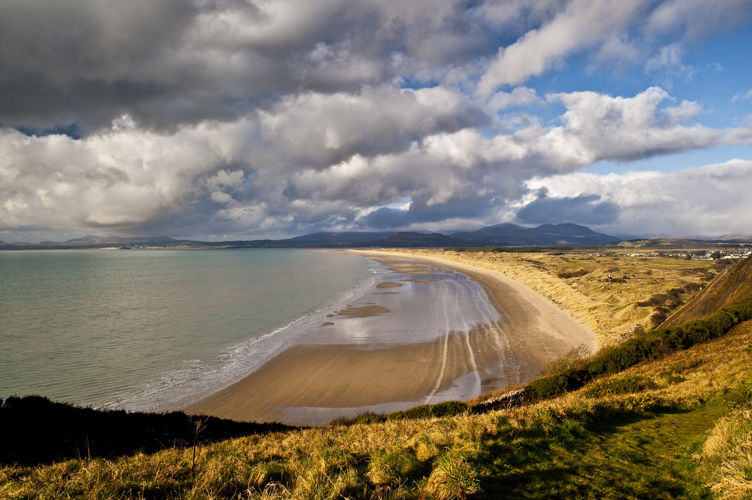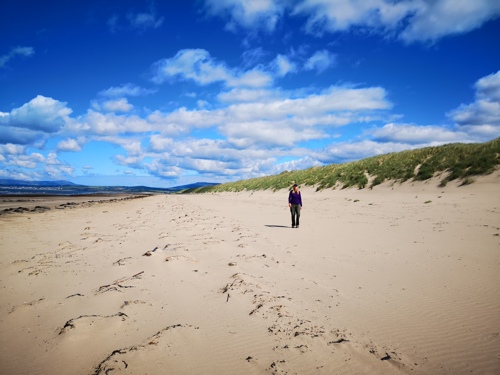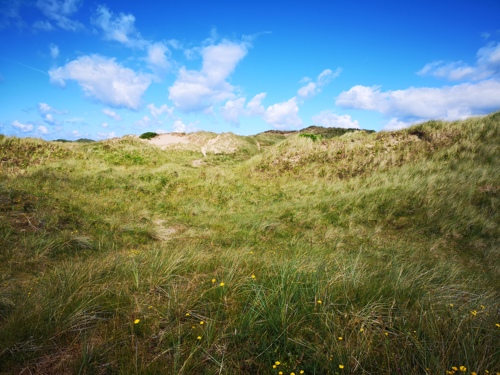Beddgelert Forest, near Beddgelert
Huge forest in the heart of Eryri National Park

We may close our car parks and other visitor facilities at short notice whilst we undertake recovery operations due to recent storm damage. You should always follow any instructions given by signs or local staff including any trail diversions or closures, and beware of the danger of falling trees or branches.
Morfa Harlech National Nature Reserve is one of the most important actively growing dune systems in Wales.
This impressive coastal landscape is one of our richest natural treasures and home to a diverse range of plants and animals, all especially adapted to life at the edge of the sea.
Together with Morfa Dyffryn National Nature Reserve in the south, the two reserves form an almost continuous area of sand dunes along the Ardudwy coastline.

There is a public footpath from Min y Don car park to the beach (turn right along the beach to reach the start of the reserve).
Some areas of the site are fenced off to allow grazing or to protect fragile dune plants.
There is a public footpath from Min y Don car park to the beach (turn right along the beach to reach the start of the reserve).
A wide range of birds nest on the beach, in the dunes and in the saltmarsh, and they are vulnerable to disturbance.
Please keep dogs on leads:
Morfa Harlech is a National Nature Reserve.
National Nature Reserves are places with some of the very finest examples of wildlife habitats and geological features.
The landscape and wildlife varies depending on which time of year you visit – here’s what to look out for.

This is a good time to see many of the flowering plants that grow in the dune grasslands and slacks.
Several nationally rare and scarce wildflowers and mosses make their home here. The wild orchids include the lovely marsh helleborine which grows alongside the northern marsh-orchid amongst beds of flag iris.
There is a whole host of brightly coloured wildflowers to enjoy from early spring onwards. Common centaury, pansies and violets put in an early appearance and they are soon followed by other coastal species including common restharrow, bird's-foot trefoil and many others.
In the warmer months, a wide variety of flowering plants can be seen in the dune grasslands and slacks. These include dune pansy, speedwells, wild thyme, and pyramidal orchids. You may also come across prickly saltwort, thyme-leaved sandwort and sea rocket on the long arc of growing dunes on the upper beach at Trwyn Harlech (Harlech point).
There are also colonies of the rather scarce lesser butterfly orchid - July is the best month to see this species.
Look out for the small copper, dark green fritillary, gatekeeper and grayling butterflies and day-flying moths such as the cinnabar and five spot burnet.
Other insects such as some of our rarest mining bees, solitary wasps and beetles depend on bare sand and you may spot a sand lizard, too.
The reserve supports populations of the purple flowered Autumn gentian.
The drier dune grasslands are well known as good habitat for rich assemblages of fungi.
The sand flats and salt marsh in the Dwyryd are important feeding grounds for wintering waders and wildfowl.
The beach is used by wading birds but, if you look offshore, you may spot wintering grebes and divers and large flocks of common scoter ducks.
Other bird species that put in an appearance at the reserve in winter include choughs, hen harriers and merlin.
There are over 70 National Nature Reserves in Wales.
Find out more about National Nature Reserves.
The Wales Coast Path goes through Morfa Harlech National Nature Reserve.
The Wales Coast Path provides a continuous walking route around the coastline of Wales.
To find out more go to the Wales Coast Path website .
Morfa Harlech is in Eryri National Park.
Eryri is the largest National Park in Wales and is home to picturesque towns and villages and the highest mountain in Wales.
It is looked after by the Eryri National Park Authority.
For more information about visiting Eryri go to the Eryri National Park Authority website.
We want you to return home safely after your visit here.
You are responsible for your own safety as well as the safety of any children and animals with you during your visit.
Please note:
For advice and tips to help you plan your visit here go to Visiting our places safely.
See the top of this webpage for details of any planned closures or other changes to visitor facilities here.
For your safety, always follow instructions from staff and signs including those for trail diversions or closures.
We may divert or close trails whilst we undertake maintenance work or other operations and we may need to close other visitor facilities temporarily.
In extreme weather, we may close facilities at short notice due to the risk of injury to visitors and staff.
You may need permission from us to organise an event or to carry out some activities on our land.
Check if you are allowed to use our land.
We recommend you follow these directions or use the Google map below which has a pin on this place’s location.
Morfa Harlech National Nature Reserve is less than 1 mile to the west of the town of Harlech.
In Harlech take the turning by the railway station signposted to the beach.
Follow this minor road (Ffordd Glan Mor) for half a mile and the Min y Don car park is at the end of the road.
The Ordnance Survey (OS) grid reference for the car park is SH 574 316 (Explorer Map OL 18).
The postcode is LL46 2UG. Please note that this postcode covers a wide area and will not take you directly to the entrance.
View this place on the What3Words website.
The nearest mainline railway station is in Harlech.
There is a bus service from the south (Barmouth) and north (Maentwrog) along the A496. There is a bus stop at the end of Ffordd Glan Mor.
For details of public transport go to the Traveline Cymru website.
The main access to Morfa Harlech National Nature Reserve is via the Min y Don car park on Ffordd Glan Mor.
The Min y Don car park is run by Gwynedd Council.
There is a parking charge.
For information about opening times and parking charges go to the Gwynedd Council website.
There are no staff at this location.
Contact our customer team for general enquiries during office hours, Monday to Friday.